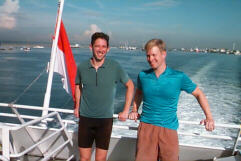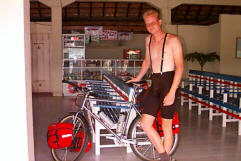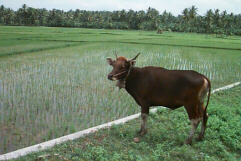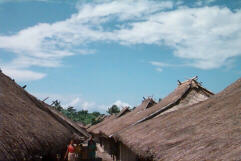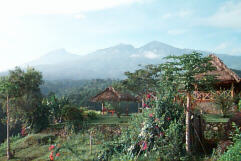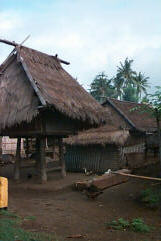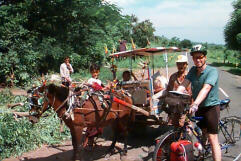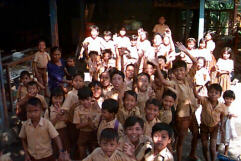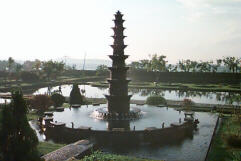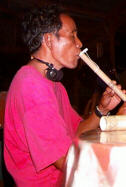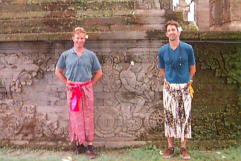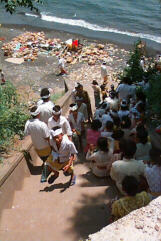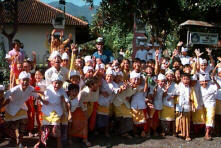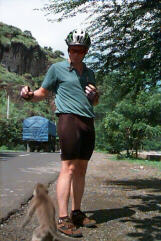| 1997 CALIFORNIA TO FLORIDA CA to AZ AZ to NM TX 1 TX 2 TX & LA LA, MS, & FL FL WESTERN EUROPE Spain & French Pyrenees France –Bordeaux & SW Coast 1 France –Bordeaux & SW Coast 2 France – Notre Dame des Cyclistes England Belgium & Holland Germany NORTHERN EUROPE Denmark Sweden Finland Estonia, Latvia, Lithuania EASTERN & SO. EUROPE Poland Slovakia and Hungary Croatia, Slovenia & Bosnia-Herzegevina MIDDLE EAST Turkey Cyprus Israel & the West Bank Zealot City Jerusalem Syndrome Jordan Egypt 1998 OTHER VOYAGES |
TRIPLOGUE
18 March, Denpasar, Bali to Sengigi, Lombok, 52km (f) Arriving in Bali was like a dream, albeit a bad one. I’d been anticipating our journey to Asia hotly but looking forward to Bali with mixed emotions. Filled with bargain-basement Australian tourists and those that prey upon them, Bali’s Kuta Beach has little to offer for me. There were few alternatives for us arriving after nine in the evening unless we wanted to take a very long nighttime cab ride to the mountains. Neither of us wanted our first riding experience here to be at night after a long plane ride. It was easy enough to find a place to stay in Legian and transportation there; one benefit is that there are a lot of options, especially with the KRISMON (Indonesian Monetary Crisis). At the beach we assembled our bikes, whereupon I discovered I’d broken a spoke in Australia. Though I found Kuta to be unbelievably hectic there is some method in the madness. Cars, motorbikes, mopeds, cars and trucks all somehow seemed cognizant of one another and respectful of their right to be there. We spent our time readying ourselves for departure and soaking up a little Balinese nightlife. Many transactions in Indonesia are unspeakably complicated. Even more so lately as their currency floats so wildly and shopkeepers try to adjust their prices accordingly. Surprisingly, finding a bike shop was a simple process; we found the spoke in only the second shop we visited. We were just about to leave the shop for another because this one did not have the right size spoke for my bike when magically the clerk found one. After one day at the beach relaxing and running errands I was ready to part. At one in the morning Andy and I discussed our ambivalence towards Bali and decided to catch a boat further east to Lombok. I noticed on the map that the fast boat to Lombok left from the port closest to Kuta and we figured we could leave early and be in a quieter place by noon. On the way to the port we worried about being able to make the boat on time. We hustled through the pulsing traffic composed of bikes, trucks, cars, horsecarts and pedestrians. The wind was with us and we passed all non-motorized traffic, finally arriving at the harbor with plenty of time to spare. The view from the Jet-Cat was spectacular. We cut our way in the narrow passage between Penida and Lembongan islands. Penida was lush and green rocky terrain tumbling to the sea, its shores cut with box shaped canyons filled with palms and with deserted sandy beaches. Lembongan, the neighbor island is shield-shaped, flat and dry. The whole way we were treated to commentary from Peter, a Dutchman and former Consul General to Indonesia. He filled our ears with stories of his diplomatic days and of the geography we were passing. Peter told me that the land masses of Indonesia west of Bali were once joined and those east as well. A massive trench always separated the two and hence the indigenous species are different east to west. We also learned of Peter’s unusual hobby, collecting cock-fighting paraphernalia. Not all cock-fighting gear, but only the decorative boxes that they keep spurs in. To date Peter has over five hundred such boxes and was on his way to Lombok to find some new ones. This left me wondering what I’d be collecting at age seventy? Arriving at the pier we met Paul the Danish cyclist. Whackily dressed in suspenders holding up his shorts, fair skin unscathed by the fearsome sun, he was leaving Indoland early because of the punishing bright orb above. He suggested an alternate route to Senggigi for us along quiet roads. If Bali had been a bad dream, Lombok became a great drug-trip. While dazzled by gazillion shades of green rendered green jungle and fields of rice we passed kampungs (villages) full of smiling waving children. We began to hear the now familiar cry "Hello Mister." The rice was being harvested and it looked more bounteous than I’d anticipated after hearing all the reports of El Nino-inspired drought. Soon the villages became more populated as we approached Mataram, the capital of Lombok and some of its neighboring islands. We stopped in Ampenan’s old port at a restaurant housed in the first bank of Lombok. Riding after lunch, the flat terrain of rice filled valley gave way to sharply rolling hills around Senggigi. Meant to be the Kuta of Lombok, Senggigi hasn’t yet caught up with its western sister thankfully. I caved into desire to connect to e-mail and spent the night in the premier hotel of the island. The Sheraton is a frightfully bad value and has no redeeming features save its exquisite grounds. They managed to add insult to injury upon our checkout by charging our credit card with rupiah after quoting us a price in dollars, inflating the normal exchange rate by nearly 25%. I’d recommend staying any place other than there! Another advantage to the Sheraton unbeknownst to us was its location. It turned out to be right next to Koco-Loco a Tex-Mex restaurant. No, we weren’t craving their food! But our friend Toha manages the café and another friend is the cook. Toha claims that his magnetic personality draws the crowd while Edy says it is his food. Judging from the show we say Toha put on, and the disappointing food, Toha is more correct.
Bye-bye Bali Sun-baked Paul calls it quits
19 March, Senggigi to Senaru, 82km (a) Having biked it twice before, I knew the road would be tough this morning. The first time was five or six years ago, when Fred, my brother Marty and I embarked on what we thought would be a leisurely pedal up the coast. While we all enjoyed the delicious, palm-shaded stretches along the beach, none of us were prepared for the sharp ascents over every headland. After three or four of these, I noticed that Fred had turned alarmingly pale. He said that the heat was too much for him and turned back. Mars and I didn’t last much longer, partly because of the lousy quality of our rented mountain bikes, but mostly due to the knowledge we’d have to return the same, hilly way. Two years later, I made my second attempt, this time with a better bike and a better plan. I found a way to make a loop out of it, heading along the brutal coast road for about 25 kilometers before heading inland and upwards through the forest road, doubling back to Mataram. I left in the heat of the day at 2:30, in order to make it back by sunset. When I finally made it to the turnoff in Pemenang –quite a few more headlands beyond where Mars and I had given up—I guzzled down a couple of liters of cold water, incredulous over not having passed out along the way. Today was a little different. We were on still better bikes and are definitely feeling more fit. And knowing exactly what lay ahead, we were psychologically prepared for it. Yesterday Paul (the Danish cyclist) told us that it flattened out once the road reached the north coast. He was right too. Just when we thought we were ready to expire from the ludicrously steep hills, we saw a cidomo coming towards us –a very good sign considering the bony ponies which pull these two-wheeled carts are incapable of managing even the slightest incline. Coconut groves and beaches gave way to rice fields and orchards. Drenched in sweat, we stopped in a bustling market town called Tanjung for a cold drink. We talked with the friendly owner at length about the monetary crisis, Indonesia’s political situation (formerly a very taboo subject indeed), and –most importantly—our eating opportunities further down the road. Stroking the head of his infant the whole time, he told us of a place called "Coffee Shop" seven kilometers further. I had visions in my mind of a happening little café with espresso, Italian pastries, and focaccia sandwiches, but of course the place was just another hole in the wall. We waited endlessly for a couple of plates of substandard noodles, watching the slow-motion parade pass by in the road. The whole scene had a slow-motion, dreamlike quality: creaky bicycles laden with grass; uniformed schoolchildren shuffling home; a tukang kaki lima peddling food from his rolling cart; old women carrying huge baskets on their heads, moving as though walking through water. Not long after lunch, it began to rain, an event we had been looking forward to, thinking it would cool things off. In reality it just made things stickier, especially when the rain stopped. The sun came out and transformed the narrow ribbon of black asphalt into an outdoor hammam. By the time we made it to the turnoff to Segentar, a traditional village, we were both awash in perspiration and grime. A tough pump up a sandy two-kilometer track made us all the more unpresentable. Just outside the vegetative wall that surrounds the village compound, we paused at a beruga (or "hangout pad" –a raised, shaded platform upon which Indonesian country-folk spend the hot part of the day) in a hopeless attempt to catch our breath and dry off. A passerby sauntered up to us and offered to show us around the village, which was neat as a pin. Orderly rows of identical houses alternated with rows of berugas, and the place was cleaner than Disneyland. Prompted by our guide, we entered a house at random. An untended fire was smoldering in one corner, while some chickens pecked around on the dirt floor. A wooden cubicle floated in the center of the dark room, and our guide explained that this room was used for storing rice and other valuables, and was occasionally transformed into a bedroom for honeymooners. Smarter than us in dealing with the midday heat, Segentar’s inhabitants lolled in the berugas set between the houses, gazing at us laconically as we strode sweatily by. There wasn’t a single "hello mister" to be heard. Unlike all the schoolchildren screaming at us from the roadside, the denizens of Segentar are accustomed to foreign tourists, or so we learned when we signed the visitors book. While only a handful of orang buleh had made it up the dirt path in the past few months, it was apparently enough to keep us from being a curiosity, even in our bizzare cycling outfits. It wasn’t far from here to Anyar, where the road turns sharply up the slopes of Mt. Rinjani. We had already learned this from our Danish compadre, who claimed the road up to Senaru was one of the toughest he’d ever cycled. Our shopkeeper friend back in Tanjung had told us it would be easy to load our bikes onto a bemo (a small pickup-like vehicle used as a bus) and he was right. When the bemo driver hesitatingly asked the princely sum of 10.000 rupiah (about a dollar) we didn’t even bother to bargain him down. Fred said it was the smartest dollar he’d ever spent, even though our ride wasn’t the height of comfort. Fred had to ride atop a big bag of rice, while I was squished between elderly peasants the whole way. The younger passengers had been displaced by our bikes and were relegated to hanging off the back as the bemo strained and bumped up the steep incline. At over 500 meters above sea level, Senaru felt wonderfully cool. We celebrated our arrival with a beer and a snack at the first lodging we found. As we waited for our food to come, we watched the resident family pick lice out of each other’s hair like a band of monkeys, and decided to explore our other accommodation options. When we announced our intention to our hopeful host, he came down in price to 8,000 rupes for a room and breakfast (about 80 cents). While some claim that the monetary crisis hasn’t affected people living in rural areas, to us it feels like locals are pretty desperate for cash. We rationalized our spending the night elsewhere as spreading our dollars around, thus benefiting more people in the village. Pondok Senaru, at two dollars a night, was far more glamorous. Most impressive was the view of a waterfall across a deep verdant gorge. The bathroom was a traditional Indonesian mandi –a basin of cold water and a plastic scoop. Invigorating! We had dinner with the other guests, a friendly young Indocouple from Bandung and an adventurous Brit on a yearlong trip who explained for us the intricacies of the "paintball industry." All three of them were climbing the mountain the next day. The Indonesians retired early, and when we had exhausted the conversational abilities of our paintball-obsessed Britannic friend, it was time for us to go back to our electricity-free room, where there wasn’t much to do beyond sleep.
Beef with rice Kampung Sengentar's skyline
20 March, Senaru toTetebatu, 70km (f) At dawn the cool mountain air was clear and for the first time this visit I saw Gunung Rinjani looming over us behind the lower crater. The morning light bathed the mountain’s lower slopes, terraced for rice and looking like a great emerald staircase to the volcano. Riding down I knew that yesterday’s bemo (small bus) ride was worth every cent of the dollar it cost us to come up. We rocketed down the bumpy road some 450 meters before leveling out and travelling upon the coast. Luckily we’d started out early; by nine-thirty I was already sweating as we rollercoastered through seaside kampungs. I’d thought that we’d be greeted by fewer schoolchildren the farther we got from the "touristy" areas of Lombok, but more and more came out from their schools to shout at us familiar greetings like "Hullo Mister." Others more inventive said "Hullo Tourist" or "Hullo Bule" which means literally "hello whitey". A few days later we joked about the perfect comeback being "Salamat ______ orang chocolate," meaning "Good _____ brown person." It was harder to figure out something to shout back to the little kids who yelled "I love you" as we pedaled by. Breakfast in the mountains was less satisfying than the last few days. I’d already become accustomed to an Indonesian traditional breakfast of nasi goreng (fried rice). A toasted Australian banana sandwich was all they offered at our accommodation, leaving me hungry after about 250 meters of riding. A kampung kitchen offered us white rice with some sort of beef sauce, but we somehow convinced the cook to cook us a couple of respectable nasi gorengs. After our hilltop snack, we got our reward for having climbed a hundred meters. A gradual downhill and tailwind swept us along through more rice fields in the shadow of Mount Rinjani. Another gradual uphill came as the sun and humidity began to bake us. Normally what would be a really easy hill left us dripping with sweat. I was now used to the sound of it dripping off my chin onto the top tube of my bike making a faint pinging sound. Again another perfect downhill accompanied by a tailwind as we turned east towards the main port of Lombok, imaginatively named Labuhan Lombok (literally: Lombok’s Port). Here the villages seemed more Muslim. Sasaks wearing their agouti-fez-like hats and tropical nehru jackets strutted down the street to mosques. Just before arriving in the port we took a dip in the ocean in order to cool down. The water felt good, but just a little too warm to do an adequate job cooling me down. Black sands and shallow waters kept the coastal tides close to the temperature of the air. Some relief came as the water evaporated off my skin when we sat in an Indonesian hangout hut readying to push on. In Labuhan Lombok we looked for a cold drink and transportation to take us into the foothills of Gunung Rinjani for the night. We sipped cold water and negotiated a charter to a little town some forty kilometers away. The price was an "outrageous" four dollars; the driver thought he was getting the best of us. The glee of our negotiation wore off all too quickly. As we gulped down the last liter of water we saw the bus driver throwing passengers off of a bus to accommodate our non-stop charter. We’d thought that we were renting one of the small empty busses. Our protests came too late and fell upon deaf ears. A deal was a deal. I dozed while Andy chatted with the driver. Sitting in the cab of the bus I couldn’t bear to stay awake and watch his careless driving. While I was sleeping he chatted endlessly about the power of his dukun (black medicine man) and the power of his charms. When questioned about it, he indicated that there was no conflict between these practices and his Muslim "faith". In transit we negotiated travelling just a little bit further, directly to our intended stop for the evening. There we had yet another snack and watched the driver proceed to drink up all of the profit he’d just made on us. He and his assistant drank beer after beer before leaving just after we checked into our hotel. We suspect that he got some kickback for getting us to stay there. He kept asking us insistently if we had checked in, if we had a key and finally disappeared silently when we did. A little boy well coached in guiding tourists and soliciting their financial support offered to give us a tour of his mountainside kampung. He led us through the padi (Indospeak for still-growing rice), filling us with facts about the flora, fauna and cultivation techniques. He also managed to slip in that his dad had recently died of cancer. Later he told us that a rich Dutch man had bought him a bike and an Australian was paying two hundred a year to keep him in school. That was due to end this year because he had failed to write his patron. When he tried to take us to his uncle’s house for tea I feared that we were in for the real "shakedown" and politely turned down the offer. When we finally reached the end I reached for a customary amount, but Andy insisted on giving him four times the sum. He asked for more and then told us we should have only given him the original amount I suggested and asked we tell no one we gave him more than that. Tetebatu itself is aspiring to be the Ubud of Lombok. Ubud is the traditional cultural center of Bali. Tetebatu has a long way to go to make their goal. Fortunately we were two of perhaps six tourists in town so our evening was a quiet one. We looked for a phone in town to call a friend who was to meet us in Sengigi the next day only to find that there were none, the closest being in Masbagik, forty-five minutes downhill by motorbike. A hotel manager offered to shuttle one of us down later on his motorcycle in exchange for petrol money. We agreed and the deal turned out to be mutually beneficial. When Andy went down the hill he discovered a line three hundred folks deep waiting to use the phones. Bule-bule (whiteys) have the right to trot right up to the front of the line and use the phone. A situation his driver took advantage of, since he too got to skip the queue. The crowds left Andy asking the question " Why are so many people waiting to use the phones?" It turns out that many have left Indonesia during the KRISMON to work in Malaysia and the crowds were waiting to call their families there. I read in the room until the power went out. Then I was lulled to sleep by the croaking of frogs, the calls of geckos and the rhythm of a gamelan practice in the distance.
Rinjani as seen from our two-dollar room Traditional North Lombok rice barn
20 March, Tetebatu to Mangsit, 72km (a) The early part of the day (pagi-pagi in Indotalk) is a great time to cycle in this part of the world. It’s cooler and shadier, plus it’s the best time of day to observe village life. This morning we were especially successful in getting an early start on the road, packing at dawn and bolting down the meager breakfast offered by our unfriendly hotel. The narrow bumpy lanes we followed down the gentle lower slopes of Mt. Rinjani were crammed with humanity –sort of like a very green version of Manhattan. We dodged dogs, scooters, horse carts, goats and all variety of toiling peasants along the way. A navigation screw-up (for which I hereby take all responsibility) dumped us onto the main road much earlier than I’d planned. While the trans-Lombok highway --only 76 kilometers from one side of the island to the other-- does carry some trucks, the vast majority of traffic was equine-powered, much to our relief. The bigger villages we passed through were jammed with cidomos; it felt like all of Lombok’s 3 million inhabitants were out on the road with us this morning. After an hour or so we turned off the busy thoroughfare and plunged back into the serenity of the Lombokian hinterland, sloping slowly down towards the coast. Kilometer after kilometer, we hardly had to pedal at all, able to appreciate our lush surroundings without so much as sweating. The only negative part of the day was learning that I’d lost a sandal somewhere along the way, having neglected to strap it onto my bags properly. Our intention had been to pass through central Mataram (Lombok’s capital), so we figured we could stop at a big shoe shop there (not to mention a sanitized, air-conditioned foodortunity), but once we penetrated the city, no one was capable of explaining where we could find such a shop. By this point, the traffic and heat had become abominable, and like most Indonesian cities, Mataram’s charm is discreet at best. After a quick snack of nasi goreng (it’s perfect cycling food, and I’m wondering when and if we’ll ever tire of it) and Magnum ice cream bars (such a treat after three days in the sticks), we headed out of town following the path of least resistance. There’d be shoes in Sengiggi, we reasoned. But once there, the pickings were pretty slim. I settled on a pair that gave me blisters just looking at them. Arriving at Puri Mas, a couple of beaches beyond Senggigi, we were surprised to find that Scott had already checked in, with boyfriend Ubai in tow, and had taken off somewhere on a motor scooter. We were shown to a beautiful bungalow by the seaside and wasted no time getting our butts into the swimming pool. It wasn’t long before Ubai and Scott showed up. The four of us spent the rest of the afternoon catching up and forecasting the future of Indonesia. As would be the case for the next few days, our evening had already been planned for us by our Lombokian friends. When we asked Epoel, the manager at Puri Mas whom I’ve known for four years, for a dinner recommendation, he told us we were expected at a party at his nearby restaurant, the Princess of Lombok. What we didn’t know was that it was a wedding party for the lovely Indo-Chinese Nina and Bruno, a charming Swiss dude who manages the Holiday Inn in Lombok. Nor did we know that all of Lombok’s queer community (most of whom I’ve met on previous visits) would be there as well. Fred and I were hopelessly underdressed. Yet even in shorts and tee shirt I sweated non-stop at the next venue. The incomparable Marina Pub was very happening on a Saturday night, swarming with the gilded youth of nearby Mataram and their many hangers-on. Whole cottage industries waited outside the doors, offering services ranging from transport to transvestite massages. We played pool (badly) and flirted with locals until closing time.
Andy runs a cidomo off the road Hello Misterrr!
25 March, Mangsit, Lombok to Tirtagangga, Bali, 72km (f) Admittedly I was more than reticent to leave Lombok. Partially because I’d had such a great time there, but mainly I was hesitant to ride in frantic Bali. So endeared to Puri Mas, we reserved the two last rooms there for New Year’s Eve 1999. So tired from all of our carrying on, I made Andy stay an extra day so I could actually rest one day before we pushed on. The day after our rest we screamed back to the port at Lembar, the wind doing most of the work. We thought we’d nearly miss the ten o’clock boat having lingered too long over coffee; instead, we arrived at the port with plenty of time to spare. We were even earlier than we thought. While Andy was buying the tickets a little boy told me that the next boat would leave at noon. I dismissed him as misinformed, the sign said clearly that the boat would leave at 10:30. We went into town to kill a few moments making some long overdue phone calls. After being informed that the boat left at ten, we rushed back and tried to board. The guard stopped us and said the all-purpose Indonesian word, "rusak", which means broken. Andy was reluctant to stray too far from the dock in the unlikely event that the boat became "un-rusak". After a few sips of cold water at the not-so-charming port café, people began to board, leading us to believe that the ferry might leave on time after all. HUH!!!! We got on, found a place on board towards the bow and started playing backgammon. We lay in port sweating our eyes out for two hours, waiting to leave though the ferry was filled to capacity. We met a couple of Aussie lads just behind us who had been surfing in Sumbawa. They were hit upon mercilessly by an Indonesian babe out for a husband. Her best trick was falling asleep on the shoulder of one of them. Mick, one of the Aussies snapped a photo of the sleeping Bali beauty while telling us a tale. He’d fallen asleep on an old woman on a bus a few days earlier. She was a less willing victim. When Mick’s buddy snapped a photo of him, Ibu (respectful term for an older woman in Indonesian, meaning "mother") elbowed him with all her considerable might. The sluggish, formerly rusak ferry miraculously got us to port a half hour before (adjusted) schedule. We climbed steadily out of the port before leveling off at around 100 meters. Cars and trucks passed us quickly and closely as we choked on their exhaust. Adding to the discomfort of the vehicular emissions was the burning of rice chafe. My eyes burned and my nose ran as we made our way to Tirtagangga. The Balinese riding experience reminded me of my last trip here. Then, we were visiting some friends at New Years Eve and everyone was imbibing but me. Because I was sober I was the designated driver. On the way to Denpasar I was struck by how complicated it was to drive in Indonesia. The road was awash with obstacles. Every form of conveyance loaded to its maximum capacity --including bicycles with bales of fresh animal feed, scooters bearing whole families, trucks top heavy with rice or hundreds of folks and their gamelan instruments on their way to a wedding or burial and bemos (small private busses) with people spilling out the doors-- all traveling at vastly different speeds, make it very difficult to negotiate the thoroughfare. And vehicles are just the start of the story. Animals and people of all sorts crowd the roadside as well. Ratty looking Balinese dogs with chafing skin or huge disgusting open wounds, goats, chickens and ducks populate the road, leaving it looking more like a barnyard. In the gutter you’ll find people bathing and relieving themselves as jamu women (seller of Javanese traditional tonics) hocking potions walk by. It is so distracting and confusing to drive that we collectively began to concoct a computer video game based on the experience. As you drive your bemo along you collect karma points for destroying evil elements by running them over. You also collect extra points for passing slower vehicles safely or by picking up passengers without running into the ever present roadside irrigation canals. No one has yet stolen the idea for the "Road to Denpasar", so we still have the chance to make our millions on it…. We descended back to sea level and then climbed again to 375 meters where we ended our day. Speedily we negotiated a two-dollar hotel room (including breakfast) and we hastily changed into bathing suits so we could spend sore (Indonesian for sunset-time) at the public baths. In Tirtagangga a Balinese king built an elaborate network of pools whose cool waters we exploited before going to dinner. Walking back from dinner to our hotel under the cover of the black sky and bright stars we choked on the smoke of dying rice fires. The haze so substantial that it cast rings around lights in town. We ended our evening with a bamboo flute concert from our host while exchanging idle chit-chat about tattoos and such with the locals.
Pool fit for a king, or two sweaty queens? Nyoman treats us to a concert
26 March, Tirtagangga to Kalibukbuk, 96km (a) The most notable difference between Lombok and Bali is the pace. While Lombok has a slow-motion, liquid quality to it, Bali feels frenzied and energetic. Some of the traffic here even appears to be in a hurry. This morning as we breakfasted, we watched the little village of Tirtagangga come to life. Schoolchildren hopped on and off bemos (no horses here), old people trotted down the road carrying burdens on their heads, backs or bicycles, while their younger counterparts rushed off on motorbikes. Our road snaked through lush jungles, offering occasional glimpses of lofty Gunung Agung, Bali’s holy mountain and an active volcano. One village we passed through seemed singularly engaged in the production of wooden mini-alters to be placed in the rice fields to hold offerings to Dewi Sri, the goddess of wet rice cultivation. It wasn’t long before we swooped down to the desolate northeast coast of the island, devastated by Gunung Agung’s eruption in 1963. Huge lava boulders littered the lumpy landscape, and the villages and traffic all but disappeared. Helped by a wind at our backs, we cruised along the good, mostly flat road, making our first significant stop in a little hole-in-the-wall restaurant at the 50km mark for yet another ultra-cheap nasi goreng. When our hostess informed us that the cold water pools of Yeh Sanih were only fifteen kilometers further, it was hard to think about anything else. Nevertheless, we made an unscheduled stop at a beachside temple thronged with elaborately dressed celebrants arriving by dumptruck from all over the island. Several gamelan orchestras were already set up on the beach and more were in the process of arriving. When I asked an intelligent-looking youth what the occasion was, it was impossible for him to explain without using Balinese words, making it frustrating for both of us. What I was able to glean from his gibberish was that today is an important holy day for the Balinese with ascetic trappings (e.g. fasting), and from what we could see, major offerings were being made to the god or gods of the sea. We watched it all from a clifftop above, afraid to go down in our inappropriate (and probably smelly) garb. If only every cycling day had a natural, spring-fed swimming pool built in to the middle of it. Yeh Sanih’s cool waters restored us wonderfully. I could have floated there all day. Fred pointed out that the clouds had rolled in, though, and that it was beginning to thunder in the hills. If we wanted to go any further today, we’d have to cruise. And cruise we did, through the increasingly busy traffic to Singaraja, making only one necessary pilgrimage stop near Kubutambahan, whose temple is famous for a carving of a dude riding a bike with wheels of lotus pedals. After making a donation and donning ceremonial drag, two local kids (incongruously in street clothes) gave us a stereophonic tour, obviously learned by rote and rehearsed many times, while a third watched our bikes. Realizing we’d exhausted our supply of small rupiah notes, we hightailed it out of there before anyone else could hit us up for funds. While our guidebook mentioned a few more temples to see along the way, we gave them a skip, both of us finding Balinese art and architecture highly overrated. With a population of 100,000, Singaraja assaulted all of our senses at once. Here, too, the beach was a hive of Hindu activity; we had to find another road in order to get through town, even then having to stop to let noisy, colorful processions pass by. We ran into the last and biggest of these on the highway out of town, an incredible cacophony of sounds, smells and dozens of golden parasols shielding ornately-decorated offerings from the sun (or in this case, the smoggy, oppressive haze). Waiting by the shoulder for the parade to get by, we were approached by a handful of sleazy-looking, Bob Marley-worshipping beach rats peskily proposing cheap accommodation, dolphin cruises, whores, massages and magic mushrooms. Obviously, we were approaching Lovina Beach, the only significant tourist development on Bali’s north coast. Since we’d ridden nearly 100 kilometers ("the most we’ve ridden yet in Asia" Fred kept reminding me), both of us felt a princess fix was needed, so we checked into the swankiest looking place around. –Which isn’t saying much; the Sol Lovina hotel caters to Australian package tourists, and was apparently built of the cheapest materials available. Still, we were thrilled to find a t.v. in our room (with CNN no less), as well as air conditioning and that most opulent of luxuries, hot water. And the 70% discount (all of Indoland is currently having a Monetary Crisis Sale) appealed to our parsimonious side. By the pool, on the (nasty) beach, and in the nearby "village", we were surprised and thrilled to spot a number of lesbian couples, many being openly demonstrative. Fred theorized that Lovina must be featured in the female version of our trusty Spartacus Guide.
Giving homage to the bicycling god Bali beach party, hindu-style
28 March, Kalibubuk, Bali to Bama, Java, 85km (f) Aside from the first day’s ride, my reticence to ride in Bali was totally unfounded. The drivers were extremely respectful to us. They seemed to understand how to deal with vehicles of varying speed, an important skill where vehicles range from horse carts to SUVs. I was already regretting that we’d be leaving the laissez-faire land of Bali and its tattooed bathing beauties behind. The still unidentified Hindu festival was in full swing as we worked our way to port. Hindu school children in their celebration garb yelled after us as we passed them on their way to school. Some more obnoxious ones exploding fire crackers on the road in front of us. A little vermin like boy chucked a little bomb at Andy. It exploded on his leg as he rode, startling him. Unprepared for the event, Andy’s water pistol was unloaded. Retribution took another form when my water bottle accidentally unloaded its contents on the unsuspecting lad and his ammunition. His friends all laughed when I apologized insincerely. A very different experience occurred when we stopped in front of a school a little later. Children in their party-wear surrounded us within a few seconds. Screaming and handling our bikes they were easily coaxed into posing for a photo or two before we went onward. Before reaching the port we stopped at a "tourist object," a temple dedicated to a lover who had been murdered by his father because the dad had fallen in love with the son’s wife to be. The unimpressive temple was up a long, sweaty, monkey-infested staircase. We’d ridden 80 kilometers in the hottest part of the day before reaching the ferry terminal at Gilimanuk. We boarded as the captain sounded the last horn indicating our departure. The bikes barely fit on the boat the deck was so crowded with cars. The narrow Bali Strait churned with wind and whitecaps. Despite the whether no one seemed fearful as the sluggish ferry chugged across the channel. What was to be a 20-minute ride turned out to be far longer; our dock was occupied so we sat in a holding pattern for over an hour before finally coming ashore. Once in Java we had a Chinese lunch with a local cop who adopted us. He arranged for a bemo to be chartered so we could make it out to a National Park where we planned to spend the night. We had decided that alternate transportation was in order because we feared that the road from the harbor would be too trafficked to ride. The road turned out to be quiet and our fears unfounded. That wasn’t to be the last surprise of the day. Before we rode into the National Park, touted to be the most accessible in Java, we shopped for provisions. We were warned, "Jalan rusak", as we started down the road. There is that word again, rusak, broken. The park ranger wasn’t kidding either, I had to stop three times to reattach and adjust my load in the first hundred meters. My packing troubles combined with the terrible road made me grumpy. Somehow the discomfort evaporated when I glided through swarms of white and yellow butterflies. The road disintegrated further. Large stretches were covered by black muddy water, others severely rutted and still other parts of the road were fields of boulders making the going very dirty and very tough. Of the fifteen kilometers only the five middle ones were bearable. At kilometer thirteen, just after passing the first (full) accommodation, we saw a huge heard of "barking" deer the park’s big natural attraction. There were several hundred off in the distance across the black muddy marsh. They bolted when I tried to ford the muck to get closer for a photo. Their golden hides disappeared into the brush as the sun dipped towards the horizon. One last mucky puddle stood between our resting point and us. There a muddy beach/bay packed with begging gray monkeys awaited us. Three buildings on stilts and a few out buildings formed the rustic lodge. We asked to be shown the yang paling mehwah (the most luxurious) one and were told flatly "tidak ada", (there isn’t one). What did we expect for sixty cents each? Bath water never felt so good as when I ladled the cool water over myself after we’d settled in. Once we’d showered we were surprised to see that others began to arrive by four-wheel-drive. A group of soldiers came to see the sore at the beach, still others here to night-fish. The lodge operator reluctantly cooked the noodles we’d brought down to the beach for dinner. Post dinner we fed the mosquitoes and played backgammon by the light of a borrowed lantern. It was too hot to sleep in our room so we dragged the mattresses from the rooms onto the picnic tables, covered ourselves with mosquito nets and sweat ourselves to sleep. I had nightmares about backtracking out of the park along the same road the next morning. A nightmare that was to be realized the next day…
Spot the brat amidst the teaming asian hoards Monkeying around
|

